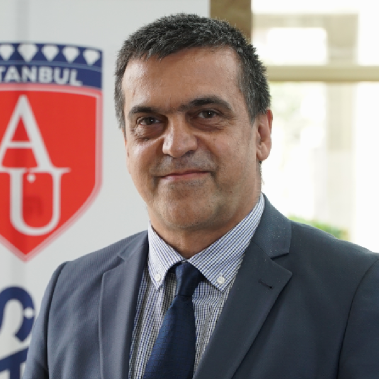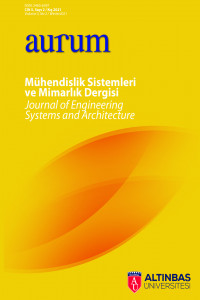Araştırma Makalesi
Sayı Editör Kurulu


 0000-0001-9336-1902
0000-0001-9336-1902


Amaç ve Kapsam
Aims
AURUM- Journal of Engineering Systems and Architecture (A-JESA) is a internationally refereed journal published biannually
(February-July) and accepting English and Turkish publications for modeling, analysis, and optimization of
complex engineering systems; and also architectural design, planning, research, education, technology, history and art.
E-mail:ajesa@altinbas.edu.tr
Web: http://aurum.altinbas.edu.tr/tr/muhendislik-sistemleri-mimarlik-dergisi
Web: http://dergipark.gov.tr/ajesa/
Scope
Range of topics eligible for publication is wide including but not limited to design, construction, operation and maintenance
of machines and more complex thermal/ mechanical/ electromechanical systems, advances in computer architecture
and software technologies, novel computational methodologies, power systems, digital electronics systems,
signal processing, communication systems, design and advancement of industrial and service systems, risk and uncertainty
analysis in complex systems in various domains.
Additionally, in architectural field research areas is wide including but not limited to architectural design studies, architectural
education, computer aided design, cinematic architecture, interior architecture, architectural criticism, construction
management, housing studies and sustainability. A-JESA publishes theory and methodology papers describing novel
approaches to the problems and issues related to engineering systems and architecture, innovative applications of the
theory, invited reviews of literature, and short communications. The journal welcomes articles on interdisciplinary engineering
and architectural research as well.
E-mail:ajesa@altinbas.edu.tr
Web: http://aurum.altinbas.edu.tr/tr/muhendislik-sistemleri-mimarlik-dergisi
Yazım Kuralları
Please fill and sign the copyright form below and upload the scanned document as a supplementary file during submission step.
Submissions without the copyright form will not be considered for review process.
Copyright form: http://dergipark.gov.tr/uploads/files/29b6/dc3b/cd93/5be58ca09ee51.pdf
If necessary, you should also fill the ethical declaration form found in submission step.
SAMPLE MANUSCRPT SUBMISSION TO AURUM - Journal of Engineering Systems and Architecture (A-JESA)
TITLE COMES HERE
Author1, Author2,
1 [Name of the Department, Faculty and University, City, Country, ORCID, e-mail]
2 [Name of the Department, Faculty and University, City, Country, ORCID, e-mail]
Abstract
Authors are responsible for submitting a complete manuscript, including an abstract of not more than 200 words, author affiliation(s) and contact details, and a final reference list, a list of image credits, and all diagrams, tables, figures, captions, and footnote citations.It is not the responsibility of the editors to add material to your manuscript. If you do not provide all the necessary sections you will be asked to add any missing material prior to editing which may eventually delay publication. Articles carry an abstract of no more than 200 words under the title. An abstract must give a sense of the focus, scope, argument and (please) conclusions of the whole paper. Author(s) affiliation, postal address, and email included on an unnumbered note above the first footnote. The author note may also be used for any acknowledgements.
Keywords: [Minimum 3, maximum 5 keywords should be given]
TÜRKÇE BAŞLIK
Özet
Türkçe özet verilecektir. İnglizce metinler için Türkçe özet, Türkçe metinler için İnglizce özet verilmelidir.
Anahtar Kelimeler: [En az 3, en çok 5 adet anahtar kelime verilmelidir]
1. INTRODUCTION
The introduction should include the objectives of the work and an adequate background. Literature survey should also be a part of this section. The authors must implicitly accept that their submission has been neither published nor submitted to another journal. If a major part of the paper has already been published, the paper cannot be accepted for publication in Aurum Journal of Engineering Systems. Papers that have been submitted in proceedings can be accepted for publication only if substantial extensions to the original proceeding paper are made, and some additional methodological contributions possibly with more significant impact than the extension results are offered. Original papers, review articles, case studies, short communications, book reviews, letters to the editors are welcome. Please ensure that you select the appropriate article type from the list of options when making your submission. Authors contributing to special issues should ensure that they select the special issue article type from this list. Any comment on or discussion of a published paper should be submitted within six months of the online publication of the paper under discussion. Submission to this journal proceeds totally online and you will be guided stepwise through the creation and uploading of your files. You may choose to submit your manuscript as a single file to be used in the refereeing process. This can be a PDF file or a Word document, in any format or layout that can be used by referees to evaluate your manuscript. It should contain high enough quality figures for refereeing. If you prefer to do so, you may still provide all or some of the source files at the initial submission.
1.1 Main Body
Main body of the text may be divided into multiple sections depending on the depth of analysis and results given in the paper. This section should first extend, not repeat, the background to the article already dealt with in the Introduction and lay the foundation for the results. Then results and discussion should be presented. Results should be clear and concise. Manuscripts should be submitted in size 12 in a readable font (Times, Arial, Calibri, etc.)(First submission). The main text and footnotes should both be double spaced and left-aligned (ragged right). Formatting the manuscript in this way is a courtesy which aids screen readability and the use of track changes and comment tools used in the editing and review process. Short papers are encouraged since the journal pages are limited. The references should be prepared according to the journal style described below. It is the responsibility of the authors to format the references in accordance with the journal’s citation style. If you do not follow these guidelines you will be asked to reformat your paper prior to editing and this may ultimately cause publication delays.
Articles should not generally exceed 40 pages (double-spaced, 12 point Times New Roman or similar font with 2.5 cm - 1 inch margins) including the reference list.
Brown, Kaplan and Jenkins (2004). If the reference has three or more authors, cite the first author’s surname followed by et al. and the year of publication – Brown et al. (2005) If there is more than one reference by the same author with the same year of publication, the first citation appearing in the text would read Brown (2006a), the second citation would read Brown (2006b), etc. At the end of the paper list references alphabetically by the last name of the first author.
Titles and subtitles in the article are to be capitalized sentence style (i.e., only the first word and proper nouns). Tables, figures and images can be submitted as part of the source files with a full caption provided in an appropriate format (see below-Fig 1). With the exception of photos or screenshots, we expect that tables and figures are submitted in an editable format. Digital files of images should be of the maximum size and resolution possible, with a minimum resolution of 300 dpi (min. length 15 cm.), and are to be provided as separate files. Authors are responsible for acquiring their own image permissions. Graphs, charts and tables should be provided in an editable format (either word processor or spreadsheet), not as static images. Authors are responsible for acquiring permission to use datasets and for the accuracy of the data they use.
1.1.1 Third degree title
Divide your article into clearly defined and numbered sections. Subsections should be numbered 1.1 (then 1.1.1, 1.1.2, ...), 1.2, etc. (the abstract is not included in section numbering). Use this numbering also for internal cross-referencing: do not just refer to ‘the text’. Any subsection may be given a brief heading. Each heading should appear on its own separate line.
Table 1. [Example of Table caption]
2. METHODS OR EXPERIMENTAL SECTION
3. RESULTS AND DISCUSSION
4. CONCLUSIONS
The main conclusions of the study may be presented in this section. If there is more than one appendix, they should be identified as A, B, etc. Formulae and equations in appendices should be given separate numbering: Eq. (A.1), Eq. (A.2), etc.; in a subsequent appendix, Eq. (B.1) and so on. Similarly for tables and figures: Table A.1; Fig. A.1, etc. Aurum Journal of Engineering Systems and Architecture publishes novel articles in English only. The preferred spelling is US English, except in citations of works published in UK English. All non-English words found in an unabridged US English dictionary should be treated as English words. In line with Chicago manual advice, Aurum follows the Merriam Webster’s Collegiate Dictionary as a source for standard US spellings, including hyphenated and capitalized forms.
Aurum Journal of Engineering Systems and Architecture follows standard US capitalization practices as per the Merriam Webster’s Collegiate Dictionary (www.merriam-webster.com). Titles of published works are always to be capitalized in headline style (i.e., all the nouns and verbs, but not the articles or prepositions unless they begin a sentence or subtitle). Aurum applies this rule to Turkish titles even where the original title is in sentence style, as in French or German titles. Thus: Raiffa, H., Schlaifer, R. Applied Statistical Decision Theory. Cambridge: Harvard Business School, 1961. Integer numbers in Arabic numerals are required for all items like equations, references, figures, tables, theorems, algorithms, proofs, notes, or any item you want to number across the paper. American separators for thousands (,) and decimals (.) are used. Thousands separators are not used for page numbers: Every year, approximately 7,500 foreign flagged ships visit US ports, carrying the bulk of shipments into the US, including 175 billion gallons of oil and other fuels. The transportation industry made $56 billion revenue out of port service operations, whereas federal, state, and local agencies were able to collect $ 16.1 billion of taxes. Wein, L. M., Wilkins, A.H., Baveja, M., and Flynn, S. “Preventing the importation of illicit nuclear materials in shipping containers,” Risk Analysis, 26(3), 1377–1393, 2006.
Numbers higher than 999,999 are written out with a combination of decimal numbers and words: The market for digital games grew 8 percent from 2014 to $61 billion, according to a new report from gaming intelligence firm SuperData Research. In the main text, tables, charts, and figures the abbreviated symbol % for percentages may be used. Ranges of dates or page numbers take a single en dash (–): Gupta, N., and Kumar, S. “Stochastic comparisons of component and system redundancies with dependent component,” Oper. Res. Lett., 42, 284–289, 2014.
5. REFERENCES
List only those references that are cited in the text. References in the text should be cited by the author’s surname and the year of publication, for example Brown (2013) or (Brown, 2013).. If the reference has two or three authors, cite all the authors’ surnames and the year of publication, for example Brown, Kaplan and Jenkins (2004). If the reference has three or more authors, cite the first author’s surname followed by et al. and the year of publication – Brown et al. (2005) If there is more than one reference by the same author with the same year of publication, the first citation appearing in the text would read Brown (2006a), the second citation would read Brown (2006b), etc. At the end of the paper list references alphabetically by the last name of the first author. Examples are provided below.
For journal articles:
Wortman, M.A., G-A. Klutke, and H. Ayhan. 1994. A maintenance strategy for systems subject to deterioration governed by random shocks. IEEE Transactions on Reliability (43) 3, 439-445.
For books:
Bersekas, D.P. 1999. Nonlinear Programming. Athena Scientific, Belmont.
For conference proceedings:
Bakır, N.O., and E. Kardeş. 2011. A stochastic game model on container security. Proceedings of the IEEE International Conference on Technologies for Homeland Security, Waltham, MA.
For chapters in a book:
Maybury, M.T. 2001. Intelligent user interfaces for all. In User interfaces for all: Concepts, methods and tools ed. C. Stephanidis. Lawrence Erlbaum Associates, Mahwah, NJ, 65-80.
For working papers:
Gehrig, T., W. Güth, and R. Levinsky. 2003. “Ultimatum offers and the role of transparency: An experimental study of information acquisition”. Working Paper No. 16-2003, Max-Planck Institute for Research into Economic Systems, Jena, Germany.
For technical reports:
Kwon, O.K., and R.H. Pletcher. 1981. “Prediction of the incompressible flow over a rearward-facing step”. Technical Report No. HTL-26, CFD-4, Iowa State University, Ames, IA.
For online articles:
Isidore, C. 2002. Hope in West Coast port talks. In CNN Money, available in http://money.cnn.com/2002/10/02/news/economy/ports/, last accessed September, 2009.
AURUM - Journal of Engineering Systems and Architecture
(A-JESA)
Etik İlkeler ve Yayın Politikası
- AURUM Mühendislik Sistemleri ve Mimarisi Dergisi (A-JESA) yılda iki kez (Haziran-Aralık) yayınlanır.
- Yazarlar tarafından ifade edilen görüş ve görüşler nedeniyle ortaya çıkabilecek etik ihlallerin sorumluluğu derginin yayıncısı, editörü ve yayın kurulu tarafından üstlenmekle yükümlü değildir ve dergide yer alan yazı ve makalelerin sorumluluğu yazara aittir.
- Dergiye gönderilen tüm makaleler en az iki uzman hakem tarafından kör inceleme (tek kör yöntemi) ile değerlendirilir.
- Dergi editörleri, hakemlerin görüşleri doğrultusunda istenen düzeltme ve önerilerin yapıldığı makalelerin yayınlanmasına karar verir. Yayın kurulu, gönderilen makalelerde düzeltme yapma, hakem süreci olumlu olsa dahi makaleleri yayınlama veya yayınlamama hakkına sahiptir. Düzeltme yapılması durumunda yayımlanmasına karar verilen makaleler son inceleme için yazar(lar)a gönderilir. Eserlerdeki hataların sorumluluğu ve dil kurallarına uygunluğu yazar(lar)a aittir.
- Yazar(lar), değerlendirme sürecinde gönderilerini geri çekebilirler. Ancak makale yayına kabul edilir ve yayımlanırsa yayından geri alınamaz.
- Dergiye gönderilen makaleler başka bir yerde yayımlanmamış veya yayınlanmak üzere değerlendirilmiş olmamalıdır. Aynı anda birden çok dergide yayınlanmak için yollanmış olmamalıdır.
- Makale işlem ücreti yoktur. Yazarlardan hiçbir ücret istenmemektedir.
- Tüm başvuru ve değerlendirme işlemleri DergiPark sistemi üzerinden yapılmaktadır.
- Etik ilkeler ve yayın politikası ile ilgili diğer durumlar için, lütfen "Editörlerin Sorumlulukları ve Sorumlulukları" bölümümüzü ve Yayın Etiği Komitesi (COPE) gibi dünya çapında kabul gören genel etik yönergeleri kontrol edin.
- Etik kurul kararı gerektiren araştırmalar için "Etik Kurul Kararları" bölümümüzü okuyun.
Dergimize yollanan makaleler intihal kontrolünden geçirilmekte ve benzerlik oranı yüksek çıkan makaleler reddedilmektedir
ULAKBİM TR Dizin tarafından alınan kararlar doğrultusunda, 2020 yılından itibaren yayımlanacak çalışmalar için Etik Kurul İzni gerekmektedir. Bu izinleri gerektiren çalışmalar aşağıdaki gibidir:
- Anket, mülakat, odak grup çalışması, gözlem, deney, görüşme teknikleri kullanılarak katılımcılardan veri toplanmasını gerektiren nitel ya da nicel yaklaşımlarla yürütülen her türlü araştırmalar,
- İnsan ve hayvanların (materyal/veriler dahil) deneysel ya da diğer bilimsel amaçlarla kullanılması,
- İnsanlar üzerinde yapılan klinik araştırmalar,
- Hayvanlar üzerinde yapılan araştırmalar,
- Kişisel verilerin korunması kanunu gereğince retrospektif çalışmalar.
Dergimize çalışmanızı yüklerken, makale dosyanızla birlikte Etik Kurul belgenizi de yükleyiniz. Çalışmanız etik kurul izni gerektiren çalışma grubunda yer almıyor ise bu durumu belirten beyan formunu imzalamanız ve ilgili durumu makale metninizde belirtmeniz gerekmektedir. Beyan formu için tıklayınız.
Ayrıca;
- Kullanılan fikir ve sanat eserleri için telif hakları düzenlemelerine uyulduğunun belirtilmesi
- Başkalarına ait ölçek, anket, fotoğrafların kullanımı için sahiplerinden izin alınması ve belirtilmesi,
- Olgu sunumlarında “Aydınlatılmış onam formu”nun alındığının belirtilmesi gerekmektedir.
2020 yılı öncesi araştırma verileri kullanılmış, yüksek lisans/doktora çalışmalarından üretilmiş (makalede belirtilmelidir), bir önceki yıl dergiye yayın başvurusunda bulunulmuş, kabul edilmiş ama henüz yayımlanmamış makaleler için geriye dönük etik kurul izni gerekmemektedir. Çalışmanızın bu durumu taşıdığını lütfen beyan formunda belirtiniz.
Çalışmanın Etik Kurul İzni gerektirmediğine dair beyan formuna ulaşmak için lütfen TIKLAYINIZ.
Etik Kurul İzni Gerektiren ve Yayına Kabul Edilen Çalışmalar
- Etik kurul izni gerektiren çalışmalarda, izinle ilgili bilgiler (kurul adı, tarih ve sayı no) yöntem bölümünde ve ayrıca makale ilk/son sayfasında yer verilmelidir.
- Olgu sunumlarında, bilgilendirilmiş gönüllü olur/onam formunun imzalatıldığına dair bilgiye makalede yer verilmesi gereklidir.
.

